Abstract
Demand for mobile data is growing at a steep rate as new markets and applications continue to emerge. There are no other solutions than to deploy additional cellular sites in greater density. These factors will directly affect the design of macrocell, small cell, and femtocells products. The radios are now multiband, and power amplifier (PA) design engineers are pushing the PAs’ output power to higher limits/levels. This article focuses on 80 W PAs with several PAs in the system. It has become commonplace to see 1400 W remote radio unit (RRU) platforms. However, network operators want these RRUs to be more power efficient, more reliable, and more compact as they increase coverage density. The point of loads (PoL) need to work over wide input voltages and wide operating temperature ranges, and most importantly they must be cost-effective. However, for applications needing 500 W or more power, the magnetics design and conduction losses in the secondary circuitry of an active clamp forward converter design have become difficult to manage because of the need for an advanced control scheme to keep the delay timing between the active clamp and the main switch gate drive. This article presents a scalable and stackable –48 VDC PoL solution that will address the high density power usage situations created by these high density networks from the tremendous growth in network traffic.
Introduction
Telecom and wireless network systems typically operate on –48 VDC power. As DC power is simpler, it was possible to build power backup systems by using batteries without the need for inverters. DC power can be stored in batteries and these batteries can continue to operate for a period of time after the utility power is disrupted. However, the –48 VDC must first be efficiently converted to a positive intermediate bus voltage before it can be boosted to power the PA or stepped down to a positive workable supply for the digital baseband units (BBU). A power supply with a capacity of 100 W to 350 W was sufficient to cover many applications. Forward converters were a good choice and have been employed for years in telecom BBUs and RRUs. With the growing demand for mobile data, new markets and applications continue to emerge. The forward converter is now severely challenged, especially when the output power requirements for these new radio designs go above 500 W. In this article, we present a stackable and interleaving multiphase high voltage inverting buck-boost controller that will resolve all the requirements/challenges to meet today’s 5G telecom equipment requirements. But first, where does –48 VDC come from and why the negative potential?
Typical Telecommunications DC Power System
Telecom and wireless networks typically operate on –48 VDC power, but why? The short story is that –48 VDC, also known as a positive-ground system, was selected because it provides enough power to support a telecom signal but is safer for the human body while doing telecom activities. It is currently accepted by safety regulations and electrical code that anything operating at or below 50 VDC is a safe low voltage circuit. Another reason is that –48 VDC allows telecom operators to easily use 12 V lead-acid batteries connected in series to act as a backup power source in the event of a grid system power failure. Negative 48 VDC is still the standard in communications facilities serving up both wired and wireless services as it is perceived to cause less (or at least inhibit galvanic) corrosion in metal than positive voltages. Figure 1 presents a simplified diagram of a typical telecommunications DC power system with an emphasis on how –48 VDC is created and distributed. The telecom DC power system typically includes the national electricity grid system, a diesel generator, a self-acting AC automatic transfer switch (ATS), a power distribution system, solar panels or boards, controllers and chargers, rectifiers, backup batteries arranged in series, and the corresponding cables and breakers.

When power from the grid is lost, the diesel generator is designed to start automatically providing AC power to the DC port system. The ATS synchronizes voltages from different sources to the equipment. Since most telecommunications equipment at the site requires a DC voltage supply, the AC power from either the electric grid or the diesel generator is converted to –48 VDC by the rectifiers. These redundant rectifiers are used to convert the AC power to –48 VDC power used to trickle charge the batteries as well as support the critical loads. The batteries, which are floating, provide the –48 VDC power to the telecom equipment or other loads if the rectifiers fail to do so. The BTS or RRH doesn’t notice the difference in the actual power source, and everything keeps operating normally. When the power comes back, the rectifiers take over again. Essentially, the entire power plant works like a large uninterruptible power supply (UPS).
The Limitations of the Forward Converter
Now that we understand where –48 VDC comes from, let’s discuss one of the industry’s most utilized PoL topologies for converting –48 VDC to positive voltages. Many telecom PoL designers use an active-clamp forward converter to implement their inverted buck-boost design. Other circuit versions that are also used are push-pull, half-bridge, or full-bridge converters. The benefits are that most of the transformer leakage energy is reclaimed via its nearly lossless recovery method. It is important for the PoL designer to first understand the basic timing that is native to the active clamp reset. In fact, a mis-sizing of the clamp capacitor can lead to an increase of the PoL’s duty cycle, which can result in transformer saturation and cause a long-term reliability effect on the main switch. Figure 2 shows a conventional low-side transformer reset active clamp forward converter circuit design. The transformer reset mechanism includes the CCLAMP and Q1.
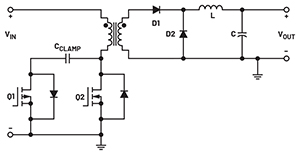
A few of the disadvantages associated with the active clamp include the need to precisely size the clamp capacitor. A large capacitor value results in less voltage ripple but introduces a transient response limitation. The active clamp forward topology necessitates that an advanced control technique be used to synchronize the delay timing between the active clamp and the main switch gate drive. Another disadvantage associated with the active clamp is that if not clamped to some maximum value, an increased duty cycle can result in transformer saturation or additional voltage stress on the main switch, which can be catastrophic. And finally, the active clamp forward converter is a single-stage DC-to-DC converter. As the power level increases—for example, 800 W equipment in 5G systems is becoming the norm—a multiphase design will exhibit more advantages for these power-hungry applications. A single-phase converter misses out on all the benefits that come with using a multiphase interleaved operation. Also, an active clamp forward design cannot be scaled to higher output power with similar results as a design with lower output power. In the next section, the MAX15258 inverted buck-boost converter is presented. Figure 3 shows a typical high level block diagram of the power supply for a 5G macro or Femto RRU board. A hot swap controller is almost universally placed in front of the –48 VDC converter. Examples of fully featured –48 VDC hot swap power managers are the ADM1073 and LTC4284, which are a great fit for these applications.
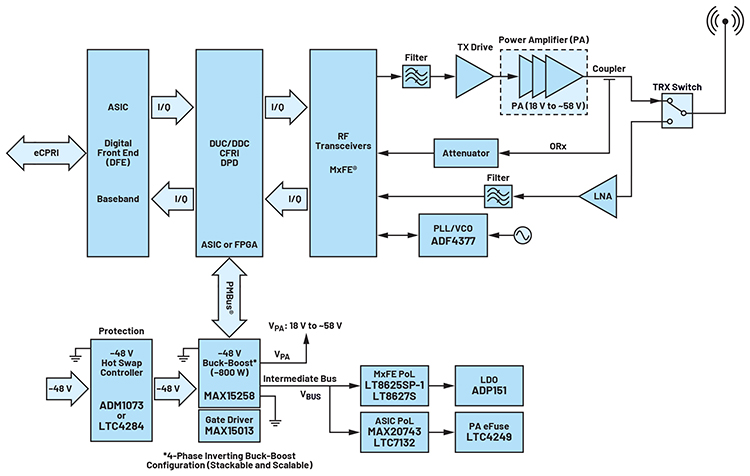
Highlighted ICs
The MAX15258 is a high voltage multiphase boost controller with an I2C digital interface designed to support up to two MOSFET drivers and four external MOSFETs in single-phase or dual-phase boost/inverting-buck-boost configurations. Two controllers can be stacked for a 3-phase or a 4-phase configuration. The device drives the phases with the right amount of phase shift to obtain maximum ripple cancellation. When configured as an inverting buck-boost converter, the MAX15258 has an internal high voltage feedback level shifter to differentially sense the output voltage. Figure 4 shows the simplified block diagram of an interleaved two-phase inverted buck-boost implementation.
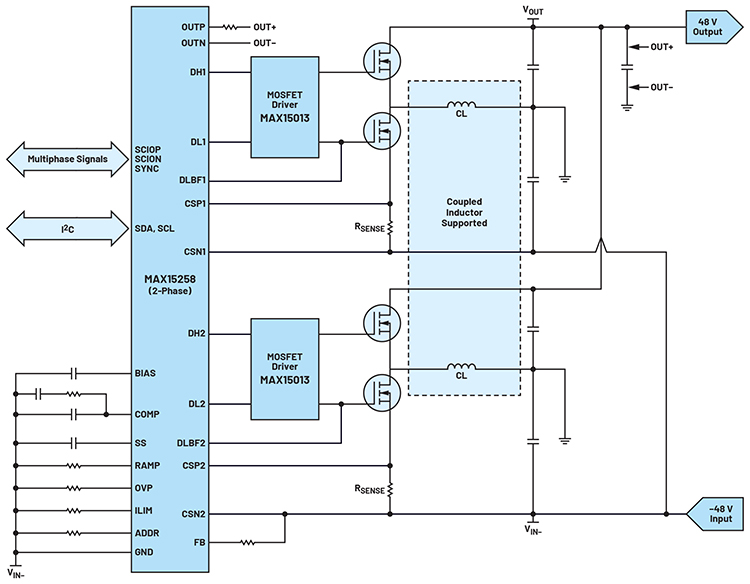
With this IC, designers do not have to account for a possible (15% to 20%) phase imbalance during their design calculation steps as they should do with forward converter designs. The controller relies on a fixed-frequency peak current-mode architecture, which provides a fast-transient response, to regulate the output. A detailed block diagram of the control loop is shown in the device’s data sheet. The device monitors the low-side MOSFET current of each phase, via the RSENSE, and uses a differential current-sense signal to ensure a proper active phase current-balance behavior when two MAX15258 ICs are stacked up in a host-node configuration. The current imbalance is applied to the cycle-by-cycle current sensing circuitry as feedback, helping regulate so that the load current is evenly shared between the two phases. In 3-phase or 4-phase operation, the node device uses the differential (CSIO+, CSIO–) signals to communicate its average current to the host controller. It is this accurate current balancing feature that has made the MAX15258 very attractive to PoL designers. Figure 5 shows the 4-phase interleaved inverted buck-boost –48 VIN to +48 VOUT 800 W power supply with the CSIO+ and CSIO– signals connecting the two controllers. Note that the SYNC pins of the two devices are also connected to ensure clock synchronization for the coordinated phase interleaving scheme.
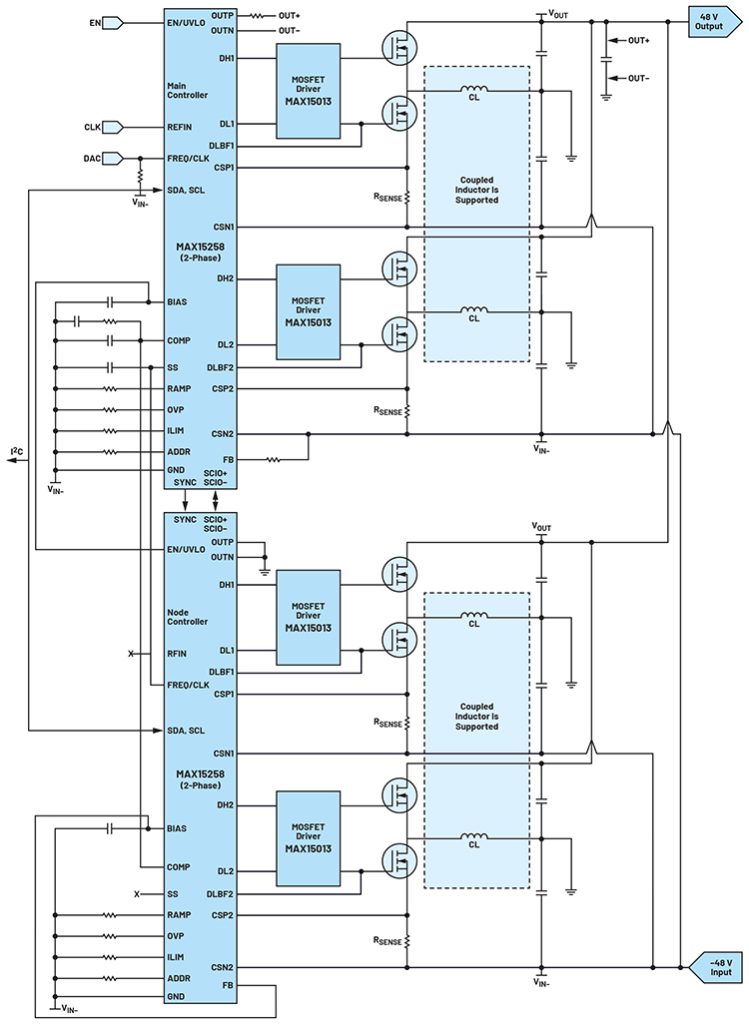
Again, the MAX15258 is fundamentally a boost converter running at a relatively low frequency. This naturally reduces the switching losses, which are the most important contributors to power loss in these converters. The device is designed to support up to 1 MHz switching frequencies. In multiphase operations, the phases run in parallel, and they all run at the same frequency (but interleaved). The total equivalent frequency is N × Freq where N is the number of phases, but the losses are those at frequency for each converter. The interleaving implementation results in some cancellation of the ripple current seen by the output capacitor. The input ripple current is greatly reduced, so smaller input inductors can be used. The use of the ADI patented couple inductor (CL) technology also helps attenuate the output ripple current, allowing the use of less expensive capacitors with lower ripple current ratings. This leads to an increase in efficiency while reducing the overall PoL PCB footprint. Essentially, this provides a lot of output power with a high equivalent total frequency but with each converter operating in a low loss region at low frequency. This is the trick that makes the MAX15258 a front runner solution for –48 VDC conversion.
The active clamp forward topology limits the ability to achieve duty cycles, making it challenging to get certain VIN and VOUT combinations to work. With telecom OEMs combining different frequency bands on the same platforms, being able to support different PA output voltage ranges has become a hard requirement. An active clamp forward converter is limited in its output power. MAX15258 meets the IPC9592B pin clearances or PCB conductor spacing requirement for peak voltages as high as 56 V. The IPC9592B standard provides a formula to calculate the PWB surface clearances for 30 V to ~100 V operational voltage, which is: Clearance (mm) = 0.1 + VPEAK × 0.01 (for example, 56 V case translates to 0.66 mm gap between high voltage pins and other pins). In the final analysis, the active clamp forward converter requires too many complicated steps to ensure that the transformer does not saturate. However, the MAX15258 automatically inverts the voltage achieving very high output power at very high efficiency with outstanding (higher) duty cycle capability. These characteristics enable scalable and stackable (up to four phases) platform design, providing a flexible and stable duty cycle control to accommodate wide VIN and VOUT ranges. Figure 6 shows the efficiency curves of a coupled inductor-based MAX15258 800 W reference design at different VIN and VOUT selections. The plots clearly show best-in-class efficiency numbers in the 98% or greater range due to lower conduction losses. All this at a lower comparative BOM cost.
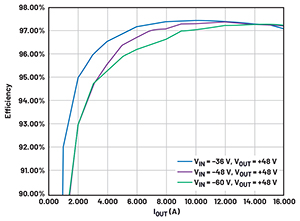
Via the I2C digital interface, the user can read back a great deal of telemetry information including VIN, VOUT, phase currents, and fault status from the MAX15258.
Also, the output voltage can be dynamically set through the digital interface. Figure 7a presents the Bode plot measured at steady state load current operation of the MAX15258 CL 800 W reference design at –48 VIN and +48 VOUT (16 A IOUT). The result is a 74.4° phase margin and –20.7 dB gain margin. Figure 7b shows the load transient response plots. As one can observe, the switched edges are very clean with virtually zero overshoot and zero ringing.
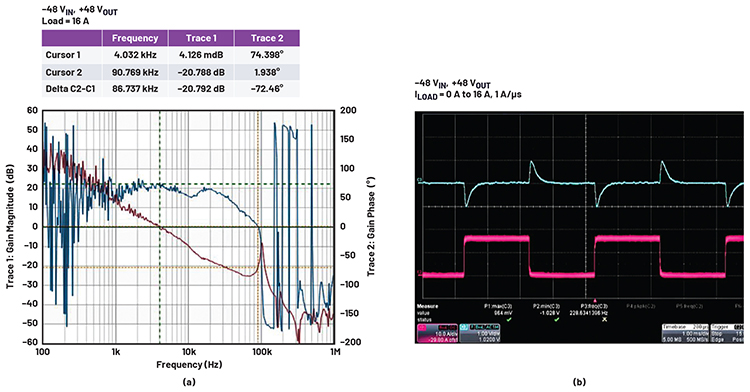
Conclusion
Network operators are going to have to install more small cells in more places faster than ever before. And of course, the PoLs in these products need to be very efficient, with ratings of at least 98% power conversion efficiency. The MAX15258 high voltage inverting buck-boost controller design is cost-effective, efficient, and scalable, allowing an easy addition and removal of phases on the same PCB layout. These benefits allow power converter designers to extend the power conversion efficiency. ADI will continue to respond to these and similar challenges by developing more –48 VDC high power conversion solutions designed for the 5G market while drawing on considerable expertise in power supply architectures.
About the Author
Hamed M. Sanogo is an end market specialist for cloud and communications in Analog Devices’ Global Applications Group. Hamed graduated with an M.S.E.E. degree from the University of Michigan-Dearborn and later earned an M.B.A. degree at the University of Dallas. Following graduation, Hamed worked as a senior design engineer at General Motors and a senior staff electrical engineer and Node B and RRH baseband card designer at Motorola Solutions before joining ADI. Hamed has spent the past 17 years in different roles, including FAE/FAE manager, product line manager, and currently an end market specialist for communications and cloud.












